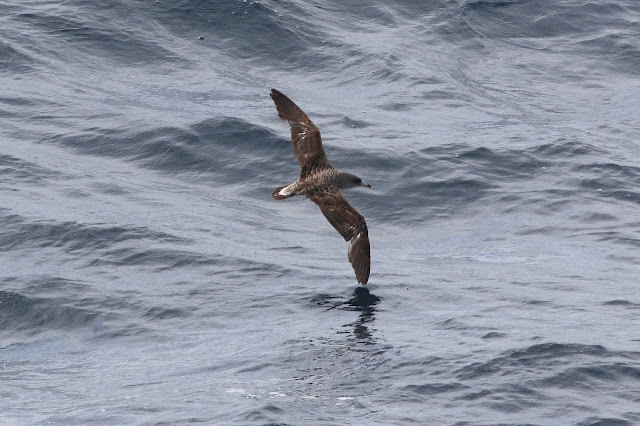I don't normally take my big lens on holiday, but was tempted this time by the possibility of seeing whales in the St Lawrence River. However, Phase 1 of the holiday was the Atlantic crossing from Southampton to New York. This was my first ship-borne crossing and I spent a lot of time scanning the waves for signs of life, but it was very quiet while we were in the English Channel. However, once we were clear of Ireland, things started to pick up.
What was amazing was the number of birds out in the open sea, even mid-Atlantic when we were 1500 miles from the nearest land. One might expect Gannets and Shearwaters, but I was surprised to see many juvenile Herring/Black-backed Gulls and even smaller gulls such as Kittiwakes. Most of the birds were juveniles and would appear in flocks of up to 10.
What was noticeable was that the birds didn't all appear on the same day. There were shearwater days and Gannet days but the two species rarely appeared in numbers on the same day. The Gannets would often fly alongside the ship, presumably taking advantage of the slip-stream in much the same way as birds fly in a "V" formation.
Some of the Gannets were sub-adults and their two-tone appearance was very photogenic.
By far the commonest sea bird was the Cory's Shearwater which would often be seen in rafts of up to 70 birds.
As the ship approached they would run along the surface of the water to take off.
There were also Great Shearwaters, but not in the same numbers when seen flying individually...........
.................but were often present in good numbers in mixed Cory/Great flocks on the sea. Here they are padding along the surface to take off.
And a nice comparison between a Cory's and a Great Shearwater, Great on the left, Cory's with the yellow bill.
So what about the "Few Surprises"? Well there were three surprises, the first being this White-throated Sparrow. It hopped aboard on the 19th September when were were sailing from Sept Iles to Sagunay in the St Lawrence River and was still with us on the 30th September when we were three days out of Southampton on our return trip. It survived through hand-outs from the passengers. At that point it disappeared and could have moved to another part of the ship or chanced its luck.
The second surprise came aboard when we were 500 miles east of New York. It is a Magnolia Warbler, an American warbler in the Wood Warbler family. Hopefully it suvived the day and a half sail into New York as not many passengers were carrying insects.
And last but not least was this female Kestrel which appeared when we were 500 miles west of Lands End on our return trip. It had obviously tried to emulate Christopher Columbus, but had bottled out after 500 miles and cadged a lift back. I assumed it survived OK as none of the passengers were throwing out Bank Voles, and in any case probably jumped ship the following day as we passed within a few miles of Land End.
Well, what an absolutely fabulous experience but it does raise questions, if not eyebrows, about some of the rare American vagrants that turn up on our shores. The ones that immediately spring to mind are the Red-breasted Nuthatch that was in Holkham Woods about 30 years ago and the more recnt White-throated Sparrow at Cley, although there are of course many more.
So where are we going in Phase 2 of our holiday?...............Canada.
See you there.




































No comments:
Post a Comment
Note: only a member of this blog may post a comment.